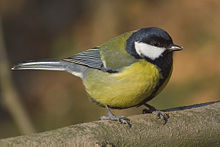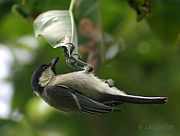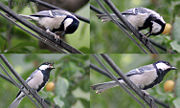Great Tit
2008/9 Schools Wikipedia Selection. Related subjects: Birds
| Great Tit | ||||||||||||||
|---|---|---|---|---|---|---|---|---|---|---|---|---|---|---|
 Male Birdsong
|
||||||||||||||
| Conservation status | ||||||||||||||
| Scientific classification | ||||||||||||||
|
||||||||||||||
| Binomial name | ||||||||||||||
| Parus major Linnaeus, 1758 |
The Great Tit, Parus major, is a passerine bird in the tit family Paridae. It is a widespread and common species throughout Europe and Asia in any sort of woodland. It is resident, and most Great Tits do not migrate.
Great Tits are easy to recognize, large in size at 14 cm, with a broad black line (broader in the male) down its otherwise yellow front. The neck and head are black with white cheeks and ear coverts. Upper parts are olive. It has a white wingbar and outer tail feathers. In young birds the black is replaced by brown, and the white by yellow.
Great Tits come in many races, but they fall into three groups. Great Tits in temperate Europe and Asia are essentially green above and yellow below. Great Tits in China, Korea, Japan and southeastern Russia are green above and white or yellow-tinged white below, and birds in India and south-east Asia are grey above and whitish below.
It is, like other tits, a vocal bird, and has a large variety of calls, of which the most familiar is a "teacher, teacher", also likened to a squeaky wheelbarrow wheel. In the 1st Movement of Bruckner's 4th Symphony several Great Tit songs are strung together in a very realistic manner. Interestingly, Great Tits from the two south Asian groups of races do not recognize the calls of the temperate Great Tits, and they may be a separate species.
Any hole will do for a nest, and it will readily take to nest boxes. The number in the clutch is often very large, but seven or eight white spotted red eggs are normal, with bigger clutches being laid by two or even more hens. The bird is a close sitter, hissing when disturbed.
Great Tits are primarily insectivores. They prefer protein rich caterpillars during breeding season to feed their young. A study published in 2007 found that Great Tits helped to reduce caterpillar damage in apple orchards by 50%. In England, Great Tits learned to break the foil caps sealing bottles of milk that had been delivered to homes to obtain the cream floating on top.
This is a common and popular European garden bird, due to its acrobatic performances when feeding on nuts or seed. It will join winter tit flocks with other species.


